As an Amazon Associate, we earn from qualifying purchases with no additional costs for you.
Swiss Army knives are a popular pocket knife and generally work with little to no issues in their operation. However, some knives experience difficulties opening and closing, either when they are new or used over time. Fortunately, there are some relatively easy fixes you can perform on your Swiss Army knife to restore it to operating normally.
A new Swiss Army knife that is difficult to open and close usually needs a drop of oil on the pivot point, and the blade worked back and forth to loosen it. Older knives need maintenance and cleaning to restore the hinge for easier opening and closing. Damaged knives should be sent for repair.
The iconic Swiss Army knife is a useful EDC knife to carry in your pocket. They are compact and useful for many situations. It should always work optimally as an EDC knife to ensure it is easy to use when required. Our guide will help you fix some opening and closing issues you may experience with your knife.
If you are interested in checking out a pocket knife with the best steel we recommend and use (Spyderco Para 3) you can find them by clicking here (Amazon link) or if you prefer the Swiss army knife we recommend this one (Amazon link).

How To Repair A Swiss Army Knife?
Like any other knife, a Swiss Army knife is a tool that sees much use and abuse and consequently requires some maintenance from time to time.
An issue that some Swiss Army knife owners experience can be difficulty opening or closing the blade or other tools on the knife.
In some cases, this can be the result of wear after use, but some issues with opening and closing can be present on a new knife just unpackaged.
It is unnecessary to return the knife to the supplier for these kinds of issues since the majority can be sorted out with a few simple tweaks.
TIP: The Swiss Army Knife is an iconic pocket knife. The popularity of this pocket knife has seen a plethora of fake products being sold as genuine articles. Check out the differences between real and fake Swiss army pocket knives:
Real Or Fake Swiss Army Knife: Focus On These 4 Differences
Can a Swiss Army Knife be Taken Apart?
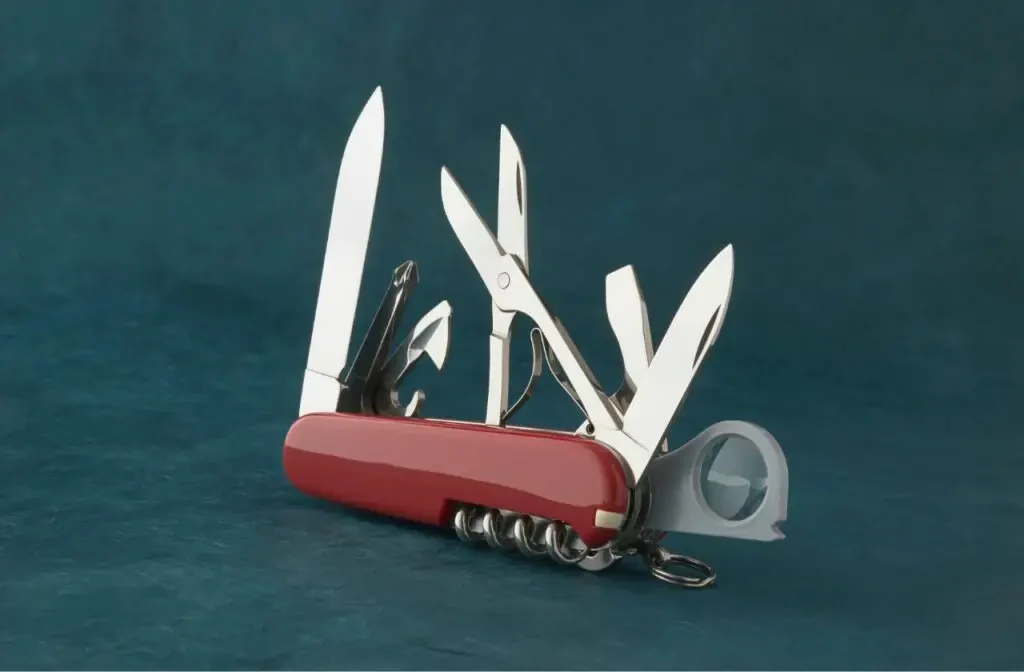
Swiss Army knives can be taken apart with some effort and reassembled with replacement pins. However, you need to be aware that taking the knife apart will void any warranty on the knife, and you will not be able to return the knife to the supplier of any problem that may develop.
Swiss Army knives are supplied with a lifetime warranty for manufacturing defects or damage the knife sustains in normal use.
Taking the knife apart yourself to attempt to repair any problems on the knife will void the warranty. If you have a significant fault with your Swiss Army knife, you should consider whether the better option would be to return it to the company to have the problem addressed.
The warranty policy on Swiss Army knives is pretty generous, and they will generally fix or replace a defective knife with no cost to you other than the cost of postage.
You should be aware that if the company cannot repair a knife because the model is out of date and no longer in production, they may replace the knife with a newer, current model. If the old knife has sentimental value, let the company know when you send the knife in. The original knife will be sent back to you if it cannot be repaired.
Popping the scales off the knife is not considered disassembly and will not void the warranty. The handle scales are designed to pop off for routine maintenance and cleaning. Removing the pins holding the knife blade and tools in place is considered disassembly and will void the warranty.
There is a growing trend to modify Swiss Army knives to customize them with different tools, but this will generally void the warranty on the knife.
The methods we discuss here to remedy closing and opening issues will not require the disassembly of your Swiss Army knife.
TIP: There are at least 18 different parts in your average pocket knife. Do you know them all? Find out all the parts of the pocket knife explained in the article below:
What Are Parts of Pocket Knife Called? ALL Parts Explained
Why Is My Pocket (Swiss Army) Knife So Hard To Open?
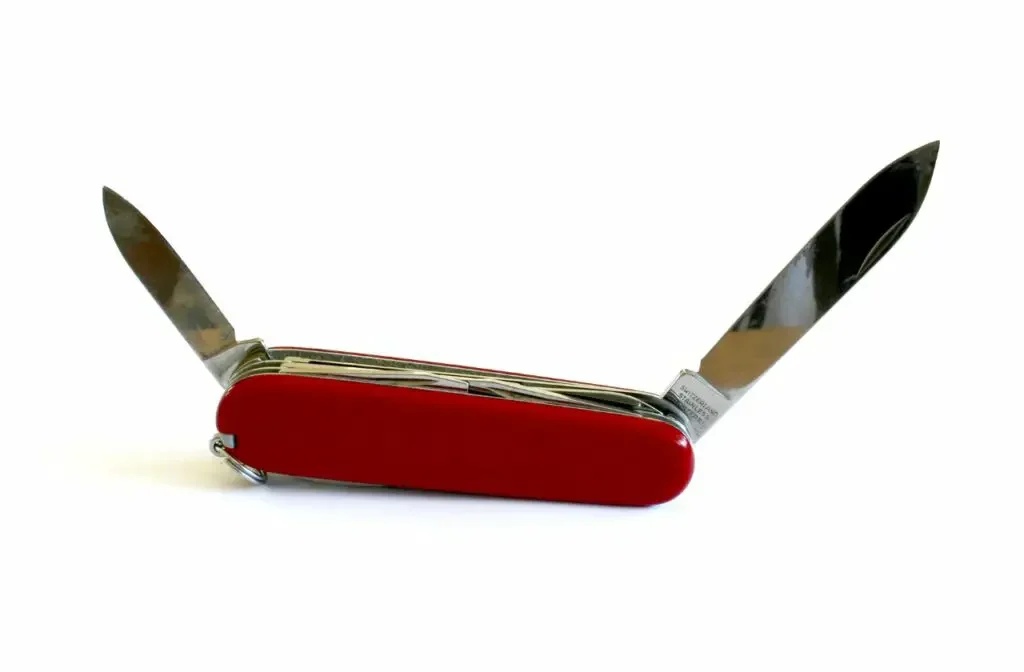
Most folding pocket knives, Swiss Army knives included, will be a little stiff to open when they are brand new. The opening mechanisms are intentionally made this way to loosen over time and with use to an ideal tension on the tools.
If the tolerances on the opening mechanism were made too loose, the hinge would become sloppy over time and would not hold the blade or tools closed properly.
Besides being brand new out-of-the-box, some additional reasons could make opening your Swiss Army knife difficult.
- Dirt. As the knife and tools are used, particles can slip into the opening mechanism and make the knife difficult to open. This is particularly true of liquids that could harden or become sticky and tacky in the pivot. Lint from your pocket can also jam up the pivot points.
- Corrosion. Most Swiss Army knives are made from stainless steel, which is resistant to rust and corrosion but not immune. The knife steel can corrode, as well as the brass pins used in the pivot point of the blade. This problem is usually from years of neglect and can make the blade difficult to open.
- Abuse. Using the Swiss Army knife for purposes other than those intended can result in damage to the tools and the blade. If the components become bent or twisted, they will jam on the sides of the slots in the knife and have difficulty opening and closing.
Most Swiss Army knives are intended to be opened using your fingernails to hook in the groove or nail nick on the blade or tool and pry it open. This opening method can be difficult if the knife is new, the hinges are caked with grime, or the knife is damaged.
TIP: If you are an owner of a Victorinox Swiss army knife, you not only need to keep it sharp but also keep it well-maintained! Check out the complete maintenance guide for Swiss army knives in the article below:
6 Care Tips on How To Keep A Victorinox Knife Sharp
Swiss Army Pocket Knife Won’t Open: How To Fix It?
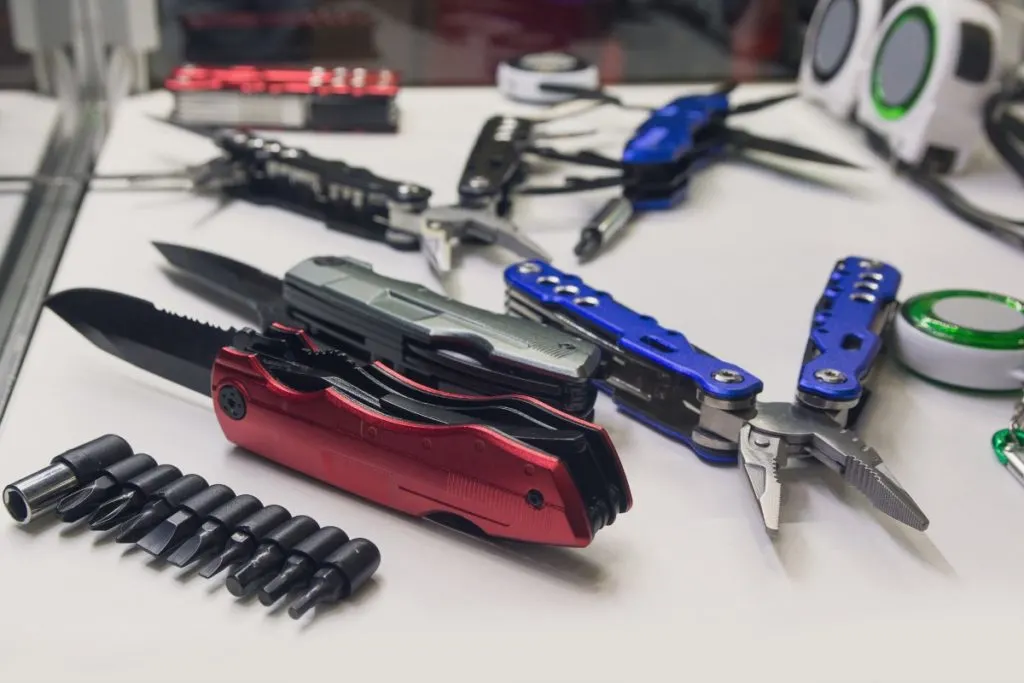
If you are struggling to open your Swiss Army knife, there are several fixes you can try to resolve the issue, depending on its cause.
Fixing a knife that is difficult to open will require establishing the main cause of the issue and then taking the appropriate steps to address that problem. In some cases, you will not be able to fix the issue, but we have some suggestions for you in this situation, too.
How To Fix A New Swiss Army Knife That Won’t Open
If your Swiss Army knife is a recent purchase and the knife is new, you should expect the blade and tools to be difficult to open.
The hinge and pivot point will loosen naturally over time and with use, but you can take steps to speed up the loosening process to make the knife easier to open.
Step 1: Oil The Swiss Army Knife Pivot Point
The first step to fixing a stiff-opening Swiss Army knife is to lubricate the joints or pivot points for the blade and tools.
The stiffness of the blade will determine the type of lubricant used. If the blade is only slightly stiff, a normal machine oil such as 3-In-One oil (Amazon link) will be sufficient.
If the blades and tools are extremely tight, you may need a lubricant with a higher penetrating capacity. A good solution for this is WD-40, which has deep penetrating capabilities. The aerosol WD-40 (Amazon link) has an advantage because the pressurized lubricant will get deeper into the hinge mechanism.
The bulk liquid WD-40 (Amazon link) will also work well, but it is necessary to soak the knife in the solution for a few minutes to achieve the desired result. It would be wise to pop the handle scales off the knife before soaking it in the lubricant.
Step 2: Work The Swiss Army Knife Blade
Pry open the blade or the tool using your fingernail. If the item is too difficult to open with your fingernails, use a small screwdriver, a key, or a coin to lift it up.
Needle-nose pliers can also be used to open extremely tight blades but put a cloth or piece of rubber in the jaws to prevent scratching the steel.
Once the blade or tool is open, wiggle it back and forth the get the lubricant to penetrate deep into the mechanism. You should feel the pivot point start to loosen up as you do this. You can also fully open the blade or tool and apply some more lubricant to the hinge while it is in the open position.
Work the tool back and forth until it reaches the desired tension.
Step 3: Clean Excess Lubricant Off The Knife
Once the blade or tool of the Swiss Army knife has loosened sufficiently, wipe the excess lubricant from the knife and the pivot point.
Close the blade and repeat the wiping process to remove oil from the other side of the hinge. It is important to remove as much of the excess oil as possible; otherwise, dirt and dust will settle on the oil, work into the hinge, and become a problem for the opening mechanism.
TIP: Lubricating your pocket knife can add years to its lifetime. Check out the complete guide on lubricating pocket knives in the article below:
Lubricating a Pocket Knife in Three Steps: Can You Use WD-40?
How To Make A Pocket (Swiss Army) Knife Easier To Open?
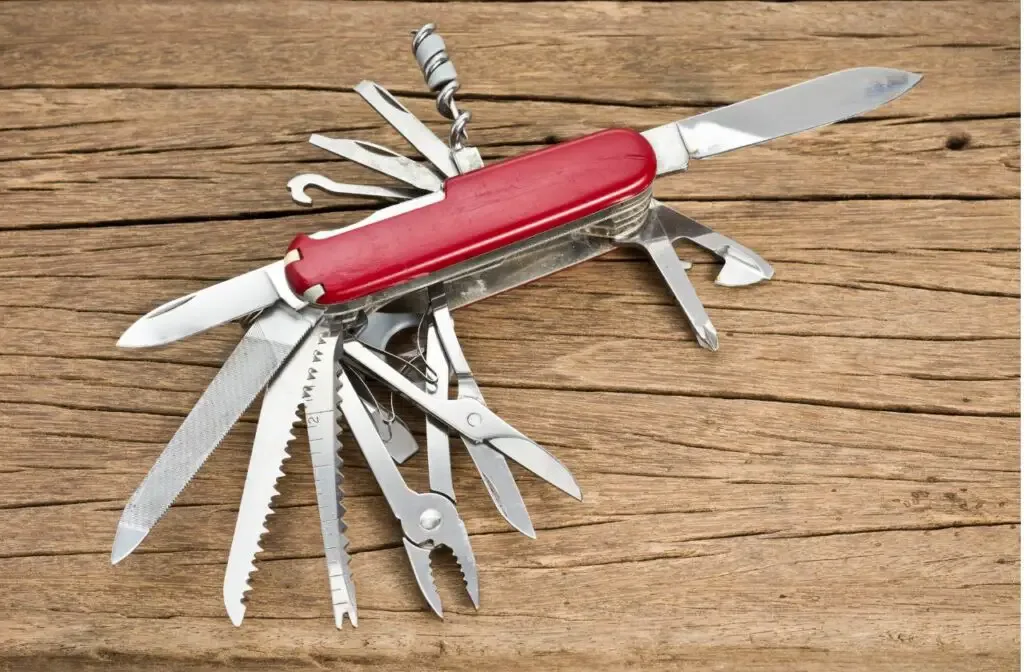
If you have an older Swiss Army knife that has become difficult to open, then the problem is generally due to dirt or corrosion at the pivot point of the blade.
The method of freeing the blades to operate freely will depend on what is causing the blades to stick.
General dust, dirt, grime, and pocket lint will accumulate in the pivot hinge, and particles of the items you cut or liquids spilled on the knife.
Over time, the build-up of this residue and dirt in the pivot hinge can cause the blades to be difficult to open. Regular maintenance of the knife will prevent most of these issues, but it is not a difficult fix if it happens.
Step 1: Brush Out The Hinge On The Swiss Army Knife
The first step in making your Swiss Army knife easier to open is to get rid of as much grime as possible from the pivot hinges of the knife.
The best method to do this is with a stiff-bristled brush, such as an old toothbrush. Brush the hinges thoroughly all around, open the blade and tools, and brush the hinges in the open position to remove as much dirt as possible.
Be careful when brushing the knife with the blades in the open position to avoid accidentally cutting yourself.
You can clean out the grooves or slots where the blades and tools rest in the closed position can also be cleaned out by running the brush through the slots.
Step 2: Soak The Swiss Army Knife
Once you have used the brush to clean the external part of the hinge, it is necessary to perform a deep clean by soaking the knife.
The best method is to fill a small dish with enough warm, soapy water to cover the knife completely. Place the knife in the water and leave the knife to soak for about 5 to 10 minutes.
Do not use boiling water for knives with plastic handle scales, as the hot water can cause the color of the handle scales to fade and discolor.
The warm, soapy water will break down stubborn dirt and sticky residue in the hinge. It will also help to remove corrosion within the hinge mechanism.
Step 3: Brush The Pivot Points Thoroughly
After the Swiss Army knife has soaked to loosen the dirt, you can brush the hinges again with the brush to remove the dislodged material.
Dip the knife in the water and swirl it around after every few brushing strokes to rinse the dirt from the knife.
TIP: Because pocket knives are always at hand, they often take quite a lot of abuse and get used for many tasks that could dull the blade. Check out the best sharpeners for pocket knives in the article below:
The 4 Best Knife Sharpeners For Pocket Knives
Step 4: Dry Your Swiss Army Knife
Most Swiss army knives are made from stainless steel, making them resistant to rust, but this does not mean they will not rust from long exposure to water.
It is vital to rinse the knife in clean water to remove the soap residue and then dry the knife thoroughly. The external parts of the knife can be dried with a soft, absorbent cloth, while you can dry the inner parts by leaving the knife in the sun for a few minutes.
Another option to completely dry the knife is by using a hair dryer or compressed air to blow the excess dampness out of the knife.
Step 5: Lubricate The Hinge On The Swiss Army Knife
Once the knife is dry, you must give the pivot points a little oil to lubricate the joint and promote easy movement. A water-displacing lubricant such as WD-40 works well for this application, but you should follow this up with one or two drops of machine oil on the pivot points.
Open the blade and move it back and forth to work the oil deep into the hinge mechanism. Do this for each tool on the knife to ensure complete coating of the internal part of the hinge with lubricant.
How To Open A Pocket (Swiss Army) Knife Fast
The opening mechanism of a Swiss Army pocket knife is intended to be used with two hands. There is no method to open the knife fast other than making sure the hinge mechanism is functioning well to make the opening process easy.
Even though the Swiss Army knife is intended to be opened using two hands, it is possible to open the blade using one hand with a little practice.
Pinch the blade between thumb and forefinger and lift it slightly from the closed position. Using your pocket or your leg as a lever, hook the knife’s handle on your leg or pocket edge and pull the blade completely open.
TIP: It happened to everyone: a bent pocket knife clip. Do you know how to fix it? Check out the complete guide on fixing a bent pocket knife clip in the article below:
DIY: Fixing a Bent Pocket Knife Clip in THREE EASY STEPS
Swiss Army Pocket Knife Won’t Close: How To Fix It?
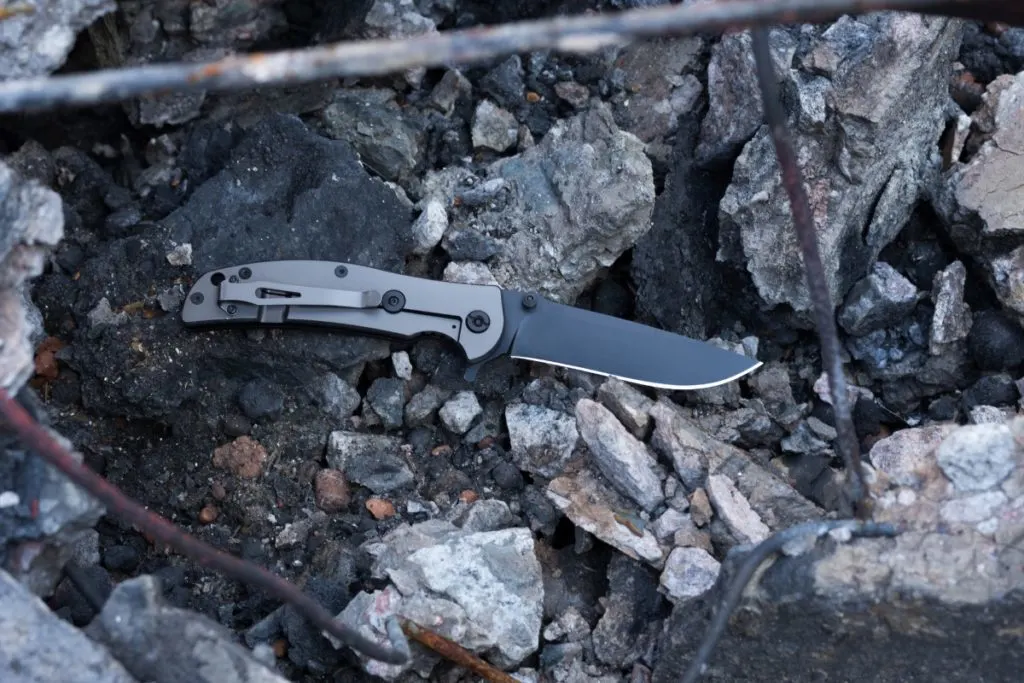
A Swiss Army knife that does not close properly is usually due to dirt in the hinge mechanism, preventing the smooth operation of the pivot.
The dirt causes friction in the hinge mechanism, resulting in the blade not closing properly. The method to fix this problem is the same as cleaning the knife hinges to promote the easy opening, which we have already detailed.
If you use the knife heavily, the blade, tools, or spacers in the knife can twist and warp, changing the alignment of the blade or tool. The misalignment will cause closing problems, making it difficult or even impossible to close the knife.
In most instances, this damage to the knife is not fixable by the knife owner and would require the knife to be repaired by the manufacturer.
If the manufacturer discovers the problem was due to the product materials or workmanship, the knife will be repaired or possibly replaced at no cost to the owner other than the post and packaging.
However, if the damage to the knife was caused by misuse, the knife will not be replaced or repaired and will be posted back to you. Your only option, in this case, would be to purchase a new Swiss Army knife.
BTW: If you want to know more about Japanese and other knives and their sharpening, check out the books listed above. These books are recommended by professional sharpeners and knife makers (Amazon links):
- Japanese Kitchen Knives: Essential Techniques and Recipes
- The Knifenerd Guide to Japanese Knives
- Knife: The Culture, Craft, and Cult of the Cook’s Knife
- Sharp: The Definitive Introduction to Knives, Sharpening, and Cutting Techniques, with Recipes from Great Chefs
FAQ: Maintaining a Swiss Army Knife Correctly
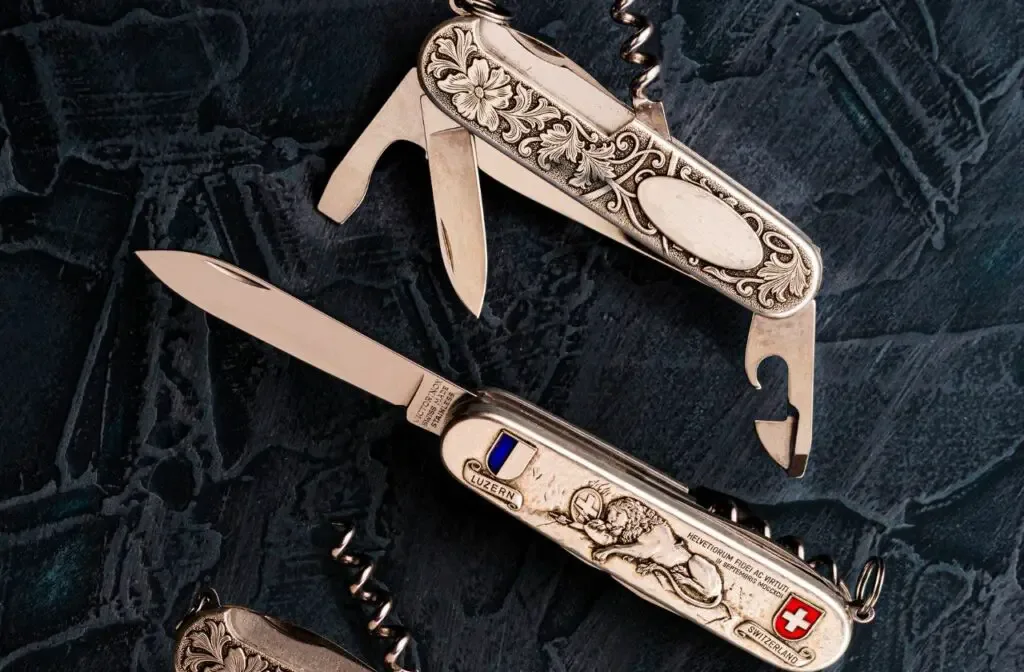
Q: How often should I clean my Swiss Army knife?
A: It’s recommended to clean your Swiss Army knife whenever you notice it becoming difficult to open or close or if it’s exposed to dirt or sticky substances. For regular users, a monthly check and clean can help maintain optimal performance.
Q: Can I use any oil to lubricate the pivot points of my Swiss Army knife?
A: While many oils can work, it’s best to use machine oil or a lubricant specifically designed for knives. Avoid using cooking oils as a lubricant for these knives, as they become sticky over time and attract and trap more dirt.
Q: Is it safe to wash my Swiss Army knife in the dishwasher?
A: No, it’s not recommended to wash your Swiss Army knife in the dishwasher. The very high temperatures and harsh detergents can damage the knife’s components and handle scales.
Q: What should I do if my Swiss Army knife gets rusty?
A: If you notice rust on your knife, clean it immediately. You can use a regular rust remover or a mixture of baking soda and water to scrub away the rust gently. After cleaning, make sure to dry the knife thoroughly and apply a relatively thin layer of oil to prevent future rusting.
Q: Will taking apart my Swiss Army knife void the warranty?
A: Yes, disassembling your Swiss Army knife, especially removing the pins, will void the warranty. If you’re facing issues with your knife, it’s best to contact the manufacturer or an authorized service center.
Q: How can I sharpen the blades of my Swiss Army knife?
A: You can use a sharpening stone, honing rod, or a specialized knife sharpener. Ensure you follow the correct sharpening angle and technique to maintain the blade’s edge and longevity.
Q: Can I replace the tools in my Swiss Army knife if they get damaged?
A: While some tools can be replaced, it’s essential to ensure that the replacements are genuine and fit correctly. It’s recommended to contact the manufacturer directly, or an authorized service center for replacements.
Q: How can I identify a genuine Swiss Army knife from a fake one?
A: Genuine Swiss Army knives have specific markings, build quality, and features that distinguish them from counterfeits. Refer to guides or contact the manufacturer to verify the authenticity of your knife.
Q: Is it okay to store my Swiss Army knife in a wet or damp place?
A: No, always store your Swiss Army knife in a dry place. Prolonged exposure to moisture can lead to rusting and degradation of the knife’s components.
Q: Can I customize or modify my Swiss Army knife?
A: While many enthusiasts customize their Swiss Army knives, be aware that modifications can void the warranty and may affect the knife’s performance or safety.
Conclusion
Swiss Army knives are durable and well-made, which is part of the reason they are so popular as EDC pocket knives. Regular lubrication and cleaning go a long way to preventing opening and closing problems that may arise with the knife through long-term use.
Taking proper care of your Swiss Army knife will ensure it is in good working order and ready to use when you need a useful multi-tool in a hurry!
TIP: Due to the varied uses of pocket knives, what steel is the best choice for these versatile knives? Check out the complete list of pocket knife steels with explanation in the article below:
Pocket Knives Blade Steel: The Best One & How To Choose

